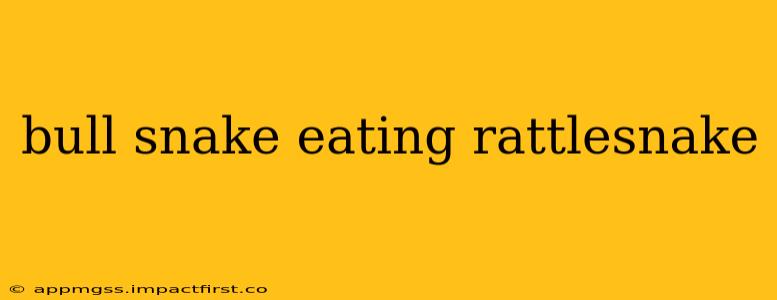The sight of a bull snake consuming a rattlesnake is a dramatic display of nature's intricate food chain. While seemingly improbable, this predatory act is a testament to the bull snake's adaptability and hunting prowess. This article will delve into this fascinating interaction, exploring the dynamics of this predator-prey relationship and addressing common questions surrounding it.
What Kind of Snakes Are Bull Snakes and Rattlesnakes?
Before diving into the specifics of predation, let's understand the protagonists. Bull snakes, also known as gopher snakes ( Pituophis catenifer), are large, non-venomous constrictors found throughout North America. They are known for their docile nature and remarkable ability to mimic the appearance and behavior of venomous rattlesnakes, a defense mechanism against potential predators. Rattlesnakes (Crotalus species), on the other hand, are venomous pit vipers possessing characteristic rattles at the end of their tails. They are ambush predators, relying on their venom to subdue prey.
How Does a Bull Snake Kill and Eat a Rattlesnake?
Bull snakes, despite lacking venom, are formidable hunters. Their strategy involves constriction. They use their powerful bodies to coil around the rattlesnake, squeezing tightly to restrict its breathing and blood flow. This process, often lengthy and demanding, ultimately leads to the rattlesnake's suffocation. Once the rattlesnake is dead, the bull snake will swallow it whole, a feat aided by its flexible jaws and highly elastic skin. The digestion process can take several days, depending on the size of the rattlesnake.
How Often Do Bull Snakes Eat Rattlesnakes?
The frequency with which bull snakes prey on rattlesnakes varies depending on several factors, including the availability of other prey, the size and age of the bull snake, and the density of both bull snakes and rattlesnakes in a given habitat. While not a staple in their diet, consuming rattlesnakes provides a significant source of nutrients for a bull snake. It's important to note that this isn't a frequent occurrence, as rattlesnakes possess powerful venom and a formidable defense mechanism.
Can Rattlesnakes Kill Bull Snakes?
While the scenario most frequently observed is a bull snake consuming a rattlesnake, it's certainly possible for a rattlesnake to strike and envenomate a bull snake. The outcome depends on factors such as the size and health of both snakes, the location and severity of the bite, and the amount of venom injected. A smaller bull snake encountering a large, healthy rattlesnake faces a higher risk of fatality. Larger bull snakes, however, have a higher chance of surviving a bite, possibly due to their size and resilience.
Are Bull Snakes Immune to Rattlesnake Venom?
No, bull snakes are not immune to rattlesnake venom. Their success in predation often relies on avoiding the rattlesnake's strike altogether, using their agility and constricting capabilities to overpower their prey quickly.
Do All Bull Snakes Eat Rattlesnakes?
While bull snakes are capable of and have been observed eating rattlesnakes, it's not a universal behavior amongst all bull snakes. Dietary preferences can vary based on individual snakes, habitat, and prey availability. Other common prey items for bull snakes include rodents, lizards, birds, and eggs.
The Significance of This Predatory Interaction
This predator-prey dynamic highlights the complex balance within natural ecosystems. The bull snake's ability to successfully hunt and consume a venomous snake underscores the remarkable adaptations found in the animal kingdom. Understanding these interactions is crucial for appreciating the intricate web of life and the importance of maintaining healthy and diverse ecosystems.
In conclusion, the spectacle of a bull snake consuming a rattlesnake is a compelling example of nature's dynamic equilibrium. While not a commonplace event, it highlights the adaptability and hunting prowess of bull snakes, showcasing the fascinating complexities of the natural world.
